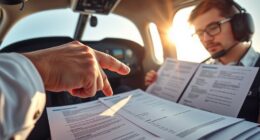Do you ever wonder what goes on behind the scenes before every flight? As a pilot, I take pride in ensuring that every pre-flight safety check and protocol is meticulously followed.
From inspecting the aircraft to communicating with the crew, each step is crucial in ensuring a safe and smooth journey.
In this article, we will delve into the comprehensive procedures and systems that are implemented before takeoff to guarantee your safety up in the skies.
Key Takeaways
- Pre-flight safety checks ensure the aircraft is in optimal condition before takeoff.
- Conducting thorough inspections and assessments reduces the risk of in-flight emergencies.
- Familiarizing oneself with safety equipment and procedures increases passenger and crew safety.
- Effective crew communication principles promote efficient coordination and teamwork, enhancing safety during emergencies.
Pre-Flight Inspection Procedures
Now, it’s time for you to follow the pre-flight inspection procedures. As a pilot, ensuring that your aircraft is in perfect working condition before takeoff is crucial for a safe and successful flight. The pre-flight inspection involves carefully examining various components of the aircraft to identify any potential issues or malfunctions.
Firstly, I begin by inspecting the exterior of the aircraft. This includes checking for any visible damage such as dents or scratches on the wings, fuselage, and tail. I also examine the landing gear, ensuring that it is intact and free from any signs of wear or leakage.
Next, I move on to inspecting the engine compartment. With utmost precision, I check all fluid levels including oil and coolant. It’s important to confirm that there are no leaks present and that all belts and hoses are securely fastened.
Afterwards, attention shifts to the cockpit area where thorough checks are conducted on various instruments and controls. I make sure that all switches are in their correct positions and function properly. Additionally, I verify that navigation systems like GPS and radios are operational.
Lastly, I examine the cabin area to ensure passenger comfort and safety. Seatbelts should be functional with no signs of fraying or damage. Emergency equipment such as life vests and oxygen masks must be easily accessible without obstructions.
Safety Equipment and Emergency Systems
Passengers should familiarize themselves with the aircraft’s safety equipment and emergency systems. It is crucial to know where these items are located and how to use them in case of an emergency. The following table provides a visual representation of the safety equipment available on most commercial aircraft:
| Safety Equipment | Location |
|---|---|
| Life Vest | Underneath Seat |
| Oxygen Mask | Above Each Seat |
| Fire Extinguisher | In Galley |
The life vest is an important piece of safety equipment, especially during water landings or emergencies. It is usually stowed underneath your seat or within easy reach in the overhead compartment. To use it, simply remove it from its packaging, place it over your head, secure the straps around your waist, and inflate the vest by pulling on the red tabs.
In case of a sudden loss of cabin pressure, oxygen masks will automatically drop down from above each seat. Pulling firmly on the mask will start the flow of oxygen. Remember to secure your own mask before assisting others, as you cannot help if you are not conscious.
Fire extinguishers are typically located in galleys throughout the aircraft. Familiarize yourself with their location so that you can quickly respond in case of a fire onboard.
Weather Conditions and Risk Assessment
Make sure to assess the current weather conditions and any associated risks before your flight. It’s crucial to prioritize safety and take into account the potential hazards that could arise due to unfavorable weather conditions. Here are four key factors to consider when evaluating weather conditions and conducting a risk assessment before taking off:
-
Visibility: Poor visibility can greatly affect your ability to navigate properly, especially during takeoff, landing, or in challenging terrain. Fog, heavy rain, or snowfall can significantly reduce visibility levels, making it difficult for you to see other aircraft or landmarks.
-
Wind Speed and Direction: Strong winds can pose a significant risk during flight operations. Gusting winds can make it challenging to maintain control of the aircraft, particularly during critical phases such as landing or takeoff. Additionally, crosswinds exceeding certain limits may require special training or alternative runways.
-
Turbulence: Turbulent air masses can cause sudden changes in altitude and movement of the aircraft. Severe turbulence can be uncomfortable for passengers and crew members alike while also potentially causing damage to the aircraft structure if encountered unexpectedly.
-
Precipitation: Rain, snow, hail, or freezing rain can impact both ground operations and in-flight performance by affecting braking capabilities on runways or creating ice accretion on critical surfaces like wings or propellers.
Aircraft Maintenance and Documentation
Ensure that you review and follow the necessary aircraft maintenance procedures and documentation to guarantee the safe operation of your flight. As a pilot, it’s crucial to prioritize the maintenance of your aircraft before every flight.
Adhering to proper maintenance procedures ensures that your aircraft is in optimal condition for takeoff and reduces the risk of any mechanical issues during flight.
Start by thoroughly inspecting all exterior components of the aircraft. Check for any signs of damage or wear on surfaces such as wings, tail, landing gear, and control surfaces. Pay close attention to hinges, fasteners, and connections for any signs of looseness or corrosion. Inspect engine components such as propellers, cowling, and exhaust systems for any abnormalities.
Next, move on to the interior of the aircraft. Ensure that all seats and seat belts are secure and functioning properly. Examine instruments, avionics systems, communication devices, navigation equipment, and electrical systems for any potential malfunctions or loose connections.
Don’t forget about fluid levels! Check fuel levels to ensure they are sufficient for your planned flight duration. Also inspect oil levels in both engine compartments if applicable.
Lastly, meticulously review all maintenance documentation associated with your aircraft. Verify that all required inspections have been completed within their designated intervals by certified mechanics. Confirm that logbooks are up-to-date with accurate entries regarding repairs or modifications made to the aircraft.
Crew Communication and Emergency Protocols
When communicating with your crew, it’s important to use clear and concise language to effectively convey emergency protocols. In the high-pressure environment of an emergency situation, every second counts, and misunderstandings can have dire consequences.
To ensure smooth and efficient communication, follow these four key principles:
-
Clarity: Use simple and straightforward language that leaves no room for ambiguity. Avoid jargon or technical terms that might confuse your crew members in a stressful situation.
-
Brevity: Keep your messages short and to the point. Time is of the essence during emergencies, so avoid unnecessary details or lengthy explanations that could delay crucial actions.
-
Repetition: Repeat important information to reinforce understanding and ensure everyone on the team is on the same page. Repetition helps overcome potential distractions or noise in a chaotic environment.
-
Confirmation: Always seek confirmation from your crew members to verify their understanding of instructions or information you have shared. Encourage them to speak up if they have any doubts or questions about what they are being asked to do.
By following these principles, you can foster effective communication within your crew during emergencies, enhancing safety and minimizing risks. Remember that clear and concise language is not only crucial for conveying emergency protocols—it also helps build trust among team members and promotes a sense of confidence when facing challenging situations together.
Frequently Asked Questions
What Are the Consequences of Not Conducting a Pre-Flight Inspection?
Not conducting a pre-flight inspection can have serious consequences. Without this essential step, potential safety issues may go unnoticed, putting both the pilot and passengers at risk.
It increases the chances of mechanical failures, such as engine malfunctions or electrical problems, which could lead to an in-flight emergency. Additionally, crucial equipment might be missing or improperly secured, further compromising safety.
Regular pre-flight inspections are vital for ensuring a safe and smooth flying experience for everyone involved.
How Often Should Safety Equipment Be Replaced or Updated?
In my experience, the frequency of replacing or updating safety equipment depends on various factors.
For instance, if we consider a hypothetical scenario where the safety equipment is used in high-risk environments or undergoes frequent wear and tear, it may need to be replaced more often.
Additionally, advancements in technology and changes in industry regulations can also impact the recommended replacement intervals.
Therefore, it’s crucial to regularly review manufacturers’ guidelines and consult with experts to ensure that safety equipment remains effective and up-to-date.
Are There Any Specific Guidelines for Flying in Extreme Weather Conditions?
In extreme weather conditions, there are specific guidelines for flying to ensure safety.
Pilots must closely monitor weather forecasts and conditions before takeoff. They need to be aware of any storms, high winds, or icing conditions that may pose a risk.
It is crucial to follow procedures such as adjusting flight plans, using appropriate equipment like de-icing systems, and maintaining communication with air traffic control for updates on weather conditions.
Safety should always be the top priority in extreme weather situations.
What Types of Documents Are Required for Proper Aircraft Maintenance?
I understand the importance of proper aircraft maintenance and the need for specific documents.
To ensure the safety and efficiency of flights, various documents are required. These may include maintenance logs, inspection reports, and repair records.
Each document plays a crucial role in tracking the condition of the aircraft, documenting any repairs or modifications made, and ensuring compliance with regulatory standards.
Without these documents, it would be challenging to maintain a well-maintained and safe aircraft fleet.
How Often Do Pilots Need to Undergo Crew Communication Training?
As a pilot, I understand the importance of effective crew communication. Crew communication training is a crucial aspect of our profession as it ensures seamless coordination and cooperation among team members.
Regular training sessions are conducted to enhance our communication skills, allowing us to effectively convey information and respond to any emergencies or challenges that may arise during flights.
Conclusion
In conclusion, pre-flight safety checks and protocols are essential for a smooth and secure journey.
Just like a meticulous surgeon carefully examines every instrument before an operation, pilots must conduct thorough inspections to ensure the aircraft’s readiness.
The attention to detail in these procedures is as vital as a magnifying glass scrutinizing every inch of an exquisite painting.
By following these protocols diligently, we can minimize risks, maintain the highest level of safety, and make each flight an impeccable masterpiece.




